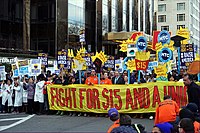
Back حد أدنى للسعر Arabic Минимална цена Bulgarian Mindestpreis German Κατώτατο όριο τιμής Greek Minimihinta Finnish Prix plancher French Minimumprijs Dutch Cena minimalna Polish Política de preços mínimos Portuguese Taban fiyat (ekonomi) Turkish

A price floor is a government- or group-imposed price control or limit on how low a price can be charged for a product,[1] good, commodity, or service. It is one type of price support; other types include supply regulation and guarantee government purchase price. A price floor must be higher than the equilibrium price in order to be effective. The equilibrium price, commonly called the "market price", is the price where economic forces such as supply and demand are balanced and in the absence of external influences the (equilibrium) values of economic variables will not change, often described as the point at which quantity demanded and quantity supplied are equal (in a perfectly competitive market). Governments use price floors to keep certain prices from going too low.
Two common price floors are minimum wage laws and supply management in Canadian agriculture. Other price floors include regulated US airfares prior to 1978 and minimum price per-drink laws for alcohol. While price floors are often imposed by governments, there are also price floors which are implemented by non-governmental organizations such as companies, such as the practice of resale price maintenance. With resale price maintenance, a manufacturer and its distributors agree that the distributors will sell the manufacturer's product at certain prices (resale price maintenance), at or above a price floor (minimum resale price maintenance) or at or below a price ceiling (maximum resale price maintenance). A related government- or group-imposed intervention, which is also a price control, is the price ceiling; it sets the maximum price that can legally be charged for a good or service, with a common government-imposed example being rent control.
- ^ "Price floor – Definitions from Dictionary.com". dictionary.reference.com. Retrieved 2008-05-02.